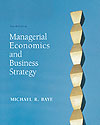This chapter was Chapter 13 in the first through third
editions of the book. It focuses on government activity in the market to correct
market failures caused by market power, externalities, public goods, and incomplete
information. The government's ability to regulate markets gives market participants
an incentive to engage in rent-seeking activities, such as lobbying, to affect
public policy. These activities may extend to international markets, where governments
impose tariffs or quotas on foreign imports to increase the profits of special
interests. In the United States, the government influences markets
through devices such as antitrust legislation, price regulation, insider-trading
restrictions, and truth-in-advertising/truth-in-lending regulations, as well
as policies designed to alleviate market failure due to externalities or public-goods
problems. The rules that affect the decisions of future managers are spelled
out in documents such as the Sherman Antitrust Act, the Clayton Act, the Robinson
Patman Act, the Cellar-Kefauver Act, the Lanham Act, the Securities and Exchange
Act, Regulation Z, and the Clean Air Act. International markets and the effects of import restrictions
are also covered in this chapter. We examine quotas, lump sum import tariffs,
and excise tariffs. Some of these policies increase profits for both domestic
and foreign firms, while some only increase profits of domestic firms while
decreasing the profits of the foreign competitors. Boxed examples showing the effects of government on the
marketplace include: False Advertisements; and Motorcycle Tariffs. This concluding
chapter takes the students through some of the rules in the U.S. that will affect
pricing behavior of the firms, and shows how regulations can benefit or harm
a specific firm in public goods settings and when international competition
is present. |




 2002 McGraw-Hill Higher Education
2002 McGraw-Hill Higher Education